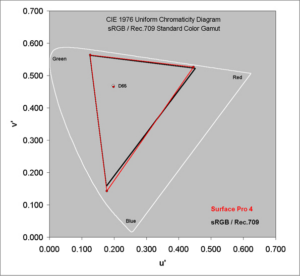DisplayMate has released another display shoot out – this time dealing with Microsoft’s Surface Pro 4 tablet (http://tinyurl.com/qdfprt2). The company writes that ‘the Surface Pro 4 has one of the very best and most accurate displays available on any mobile platform and OS’.
Compared to the Surface Pro 3, the new tablet has a higher resolution (2736 x 1824 vs 2160 x 1440), leading to higher ppi (267 ppi vs 216 ppi) and 60% more pixels. In fact, every display performance metric has been improved, including maximum brightness, contrast ratio, absolute colour accuracy, viewing angle performance and screen reflectance.
The Surface Pro 4 has a 12.3″ display with a 3:2 aspect ratio. The aspect ratio is referred to as ‘an excellent compromise’ between 4:3 and 16:9. The 267 ppi pixel density is ‘excellent’ (DisplayMate notes that it would be called a retina display if produced by Apple), and appears perfectly sharp at viewing distance of 16″+. The tablet uses sub-pixel rendering (Microsoft refers to this as ClearType), which improves text sharpness – by up to a factor of three, for black, white and grey images.
Colours on the Surface Pro 4 are the most accurate that DisplayMate has ever measured for any tablet, for the sRGB colour space. The gamut is 102%. The Average Absolute Colour Accuracy is 1.9 ‘Just Noticeable Colour Difference’ (JNCD), which is typically indistinguishable from perfect. The Maximum Colour Error is 4.1 JNCD, which is larger, but it is centred on blue, which is less visually important (see http://tinyurl.com/m7l88pv). Microsoft individually calibrates every Pro 4 display on the production line, to optimise the colour gamut and white point.
The Intensity Scale (Grey Scale) controls the contrast of displayed images, as well as how the RGB colours mix to produce on-screen colours. It is very easy to get this wrong, but the Surface Pro 4’s scale is a close match to the sRGB/Rec.709 standard. It is very smooth and (logarithmically) straight, but slightly less steep: gamma is 2.13 compared to the standard 2.2.
Display brightness is 436 cd/m², which is very good – among the highest for 9″+ tablets. However, this is less important for the Surface Pro 4, which is unlikely to be used outside often. A more important metric is the contrast ratio – the difference between the peak white brightness and darkest black luminance. Black luminance was measured at 0.31 cd/m², meaning that the ‘True Contrast Ratio’ is 1,406 (Microsoft lists it at 1,300) – among the highest DisplayMate has ever measured for a mobile display.
Measured screen reflectance – thanks to the optically bonded cover glass – is 5.6%: lower than most other mobile devices, but much higher than the iPad Air 2 (2.5%). Contrast Rating for High Ambient Light, which measures readability in ambient light, was 78, which is very good, although much lower than the iPad Air 2’s 166.
The IPS/PLS display in the tablet means that the Surface Pro 4 exhibits very small colour shifts with viewing angle: contrast ratio was measured at 809 in landscape mode and 865 in portrait, at a 30° angle: the highest DisplayMate has ever measured for an LCD tablet. There was, however, a 50% fall in brightness, as with most LCD displays.
Display power efficiency could be assumed to be higher than most other tablets, being larger and with a higher resolution. However, the Surface Pro 3 actually uses less power than many smaller models.
Ray Soneira, president of DisplayMate, ends the shoot out with his advice for tablet display makers. The most important improvements – for both LCD and OLED mobile displays – will come from improving image and picture quality, and screen readability, in real world ambient light. The key will be in lowering screen reflectance and implementing dynamic colour management, with automatic real-time modification of the native colour gamut and intensity scales based on the measured ambient light level in order to have them compensate for the reflected light glare and image wash out from ambient light.

